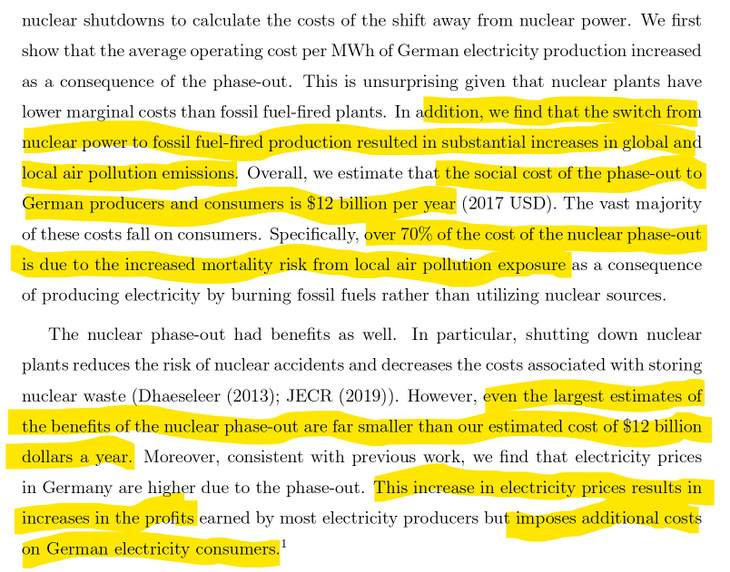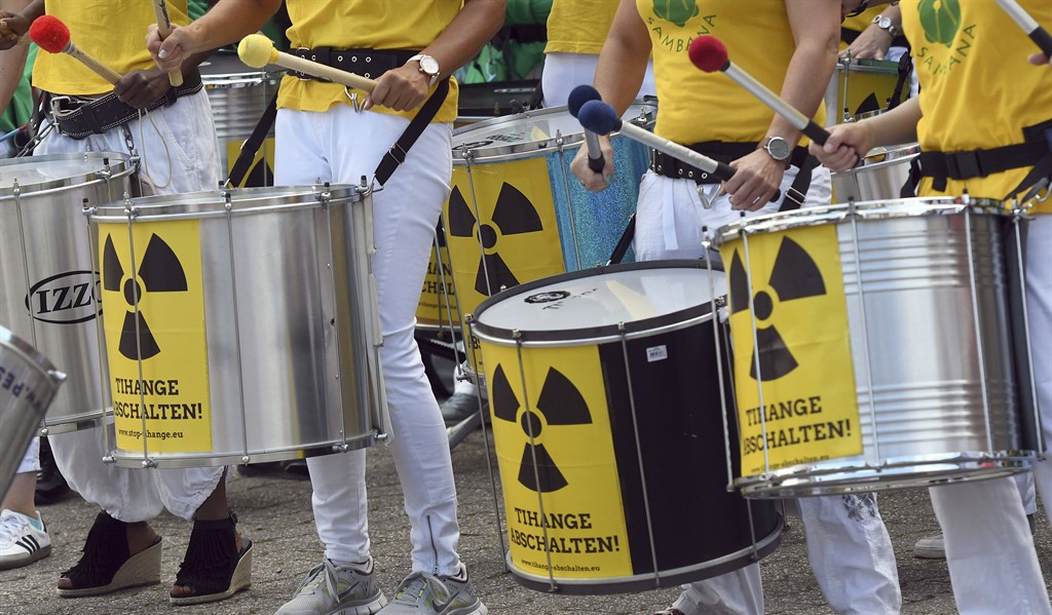There’s not much good to be said about the end of nuclear power in Germany. And the further were get from the reactors going dark, the dimmer the idea and the rationale for it looks.
Take what “electric” means to the average German today, for the most basic effect.
Germans pay the highest prices for electricity in the world and many consider it a 'luxury good.'
This graph explains why: 👇https://t.co/r5VcoiAgYz pic.twitter.com/KOUqAk755d
— Steve Milloy (@JunkScience) May 10, 2023
German leaders, especially those in the Green movement like Economics Minister Robert Habeck, are tapdancing even more so than when I posted about it two weeks ago. Only then they were worried about their own political survival as a ruling party.
Now, they’re worried about German industrial collapse.
Minister Habeck said nuclear electricity couldn't substitute for natural gas consumption
He now says industrial electricity must be subsidized to help companies decarbonize by electrification
The numbers in his plan rely on power somehow getting cheaper as reliable plants close
— Mark Nelson (@energybants) May 7, 2023
The lights on are a “luxury item.” When even your most committed German Greens and liberals are asking “What did we do to ourselves?” not three weeks after the last reactor shut down?
The fact that geologically stable Germany is shutting down nuclear power due to a tsunami in Japan must be the least rational decision a democratic country has made since, like, Bush/Blair claiming they had God's support to invade Iraq.
— Elias Rosell (@RosellElias) May 10, 2023
The country is in some hot frickin’ water.
And now data is coming in – or maybe it was always there to begin with and was kept from the citizens – that shutting down perfectly good, relatively clean nuclear reactors in favor of unreliable and hugely expensive renewables with fossil fuel fired plant back-ups wasn’t quite the brilliant plan it was made out to be to begin with for saving the earth…or the country.
…Whether countries want to build new nuclear plants, data suggest that keeping existing ones running is a win for the climate and for health. Germany’s numbers show why.
It has the second-most carbon-intensive electricity grid in the Group of Seven, beaten only by Japan, which is now restarting some of its nuclear plants. In Europe, only Poland and the Czech Republic have a more carbon-intensive mix — and Poland is building more nuclear to fix this. To produce one unit of electricity, Germany emits about 8.5 times more carbon dioxide than Sweden and about 4.5 times more than France. And those figures were from 2022 when Germany’s last three nuclear plants were still contributing around 6 percent of its power.
Few countries in Europe or North America depend as heavily on coal, which supplies roughly one-third of Germany’s electricity. That’s about twice the average in the European Union. In Spain, coal contributes 3 percent, in the United Kingdom, 2 percent. Countries that get less than 1 percent of their electricity from coal include France, Sweden, Austria, Portugal and Switzerland.
Good grief. When it’s laid out on paper, Germany electricity-generation-wise is practically a Soviet-bloc country as far as pollutants in the air, and has just made itself worse!
…Worse, the fall in nuclear power has offset more than 70 percent of the energy Germany has added from renewables. Since 2010, renewables output has gone up by 145 terawatt-hours (TWh) — one terawatt-hour is the annual electricity use for around 140,000 Germans. Meanwhile nuclear energy production has gone down by 104 TWh and coal by just 82 TWh. So the nation’s net increase in low-carbon energy was just 41 TWh.
The counterfactual is sobering to crunch. Had Germany kept its nuclear plants running from 2010, it could have slashed its use of coal for electricity to 13 percent by now. Today’s figure is 31 percent.
Not very well done by the Green Dreamer schemers, no? Who sold the German people a bill of goods like that?
*looking at YOU, Merkel*
It’s not like there weren’t studies available that could have put a lid on some of this over-enthusiastic rush to power Armageddon. Back in 2020, the Energy Institute at Hass (Berkeley) published a well-regarded and pretty much ignored paper which spelled out quite clearly what the pitfalls of losing the nuclear reactors would be:
The Private and External Costs of Germany’s Nuclear Phase-Out
And remember, these are 2017 dollars they’re talking about. Not 2023 dollars – considering what has happened in the interim, with the Ukrainian conflict and skyrocketing energy prices? Exponential increase in the estimates of collateral pollution damages and additional energy costs.


Pretty damning stuff, if I do say so myself…
…The main argument campaigners level against nuclear power is that it is dangerous. In fact, worldwide, coal causes the most deaths per unit of electricity produced, including through local air pollution. Germany’s story is a case in point. Lignite — the type of coal that the country relies on — is the dirtiest, releasing sulfur dioxide, nitrogen oxides and other particulates. Some estimate that these pollutants have caused thousands of excess deaths since Merkel’s reversal, due to cardiovascular disease, stroke, chronic obstructive pulmonary disease (COPD) and lung cancer.
Unless, of course, the idea is that the less people the better, and they clean up afterward. That fits the WEF model.
Don’t think the rest of Europe, for all their Gaia pearl clutching, isn’t watching Germany circling the drain. And making their moves to avoid their own flush.
ITALY STARTS RETURN TO NUCLEAR
Germany's isolation deepens.
Italy, land of Fermi and much early work in nuclear power, stripped out their reactors after Chernobyl in 1986.
Italy's still home to leading nuclear part suppliers.
Nuclear comeback coming.https://t.co/8BlTf6Zeo6
— Mark Nelson (@energybants) May 10, 2023
Nothing like the neighbors doing the exact opposite when you’re making a fool of yourself.
DENMARK TO CONSIDER NUCLEAR
Denmark is the leading wind power country.
Yet a single reactor coming online in Finland will make nearly as much energy as 30 years of Danish wind turbines.
Denmark's now looking to learn from its own and Germany's experience, by exploring nuclear. https://t.co/4AwZOhX6l9
— Mark Nelson (@energybants) May 10, 2023
Even here in the U.S., nuclear is coming right along in the court of public opinion.
A Gallup survey released in late April found that 55 percent of U.S. adults support the use of nuclear power. That’s up four percentage points from last year and reflects the highest level of public support for nuclear energy use in electricity since 2012.
…But nuclear power doesn’t produce carbon emissions, and it’s more consistent and reliable than wind and solar energy, which vary depending on the weather. For these reasons, the Biden administration has identified nuclear energy as a key climate solution to achieve grid stability in a net-zero future. The administration is pushing for the deployment of a new generation of reactors called “advanced nuclear”: a catch-all term for new nuclear reactor models that improve on the safety and efficiency of traditional reactor designs.
We’ll see if POTATUS and crew follow through, but I believe the American people know they’re being taken for a Green ride.
Yeah. Bet the farm on solar and wind.
Lightning strike-caused fire that put one-seventh of Ireland's offshore wind production out of action last fall. pic.twitter.com/j4wVIUjezj
— Steve Milloy (@JunkScience) May 10, 2023
Brilliant.
Wait ’til your average German gets wind of the truth.
Sorry. Couldn’t help myself.








Join the conversation as a VIP Member